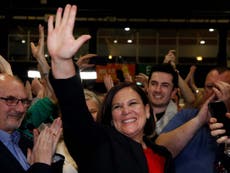Whatever your feelings about Sinn Féin, their influence should not be discounted
People who felt ignored, forgotten and unrepresented by any of the traditional Irish parties finally felt heard, and so Sinn Féin gained traction across the country

Since the founding of the Irish Republic, there have been two main political parties, Fine Gael and Fianna Fail. But where in Britain the Tories very much occupy the right side of the political spectrum and the Labour party the left, both Fine Gael and Fianna Fail have offered up only centre-right politics to Irish voters, taking turns at the top for the last 100 years.
Until the most recent election, that is.
In 2020, Ireland’s left – in the form of Sinn Fein – delivered its strongest ever election performance.
Once the counting from Ireland’s single transferable vote system had concluded (ie a much longer time after polls had closed than we are used to in the UK), Fine Gael had delivered the worst result in the party’s history. Fianna Fail fared slightly better – though the result was only marginally better than its own “personal worst” (the 2011 election).
Ah yes, the 2011 election – where voters took into account the fact that whilst Fianna Fail had overseen the unbridled capitalist wet dream that was the Celtic Tiger, it was actually the architect of an unmitigated disaster in the form of the property bubble, credit crunch and subsequent bank guarantee with its crushing obligations. Once the counts were done, Fianna Fail had gone from 77 seats in the 160-seat chamber to 20 and was, most definitely, no longer in power.
In the 2016 election, it was the Labour Party’s turn to be eviscerated by the electorate, falling from 37 to just seven seats. After its spell in coalition with Fine Gael, Labour was bundled up into the establishment, which seemed unable or unwilling to fight back against the excruciating demands of the terrifying troika. It ceased to represent the working people of Ireland – at least in the eyes of the voters – and it paid the price.
By this time, Sinn Fein and a few other left-wing groups had already begun to establish themselves as the only real alternative to the shades of grey in the three main political parties.
Sinn Fein’s then-leader Gerry Adams had served several years as a TD in the dail (the Irish parliament) and recast himself in the eyes of many through his quirky social media presence, posting videos of himself cooking and bouncing on a trampoline with his dog. This, coupled with a growing number of Sinn Fein local councillors, enabled the party to undergo an image overhaul in the eyes of voters, leading to a growing number of TDs.
Sinn Fein spoke out against the harsh conditions imposed by the troika on the Irish people, blaming politicians for leading the general public to believe that everything was “absolutely grand – great, in fact”, and that there was nothing odd at all in the world and his plumber becoming a property developer across the country before the crisis hit.
The party also complained about the spiralling costs of housing, health coverage and the country’s approach to taxing multinational corporations. People who felt ignored, forgotten and unrepresented by any of the traditional Irish parties finally felt heard, and so Sinn Fein gained traction across the country.
It reaped the benefits in the 2020 election, but even the party didn’t quite expect what happened. Last year, it performed poorly in the local and European elections and decided to field just 42 candidates for the 160 seats up for grabs.
However, the last 12 months has told a tale of two Irelands. To many on the world stage, Leo Varadkar acquitted himself well whilst navigating the brave new world of Brexit. Meanwhile, at home, people grew increasingly fed up with a growing number of societal issues. It felt as though the government was pouring all its time into looking good abroad while the main topics for voters were closer to home: health and housing.
It can cost upwards of €50 (£42) to see your GP, unless you have a medical card. One hospital in Waterford has just announced it will not be accepting any urology referrals for six months. A recent report by the Health Information Quality Authority found that staff shortages are threatening the sustainability of the country’s maternity services. According to the Irish Hospital Consultants Association, there are currently 776,499 patients on waiting lists at an acute care hospital and 53,000 children are waiting for care at one of the country’s three children’s hospitals – of a national population of roughly 4.9 million.
Meanwhile, house prices generally go only one way in Ireland: up, and way up. In Dublin, queues form outside rental properties for viewings and if you’re not one of the first two people to cross the threshold, you often haven’t got a snowball’s chance in hell of making it your home. Home ownership is actually at its lowest in 50 years.
The ongoing chatter about Ireland’s success attracting some of the world’s biggest businesses neglects to mention that these companies tend to set up in the ever-enriching east coast – particularly in Dublin itself, with a few exceptions in other cities.
So, the appointment of Leo Varadkar as taoiseach (prime minister) in 2017 may have seemed to the world as a sign of increasing social liberalisation of the Irish people. But in reality, whilst having an openly gay man of Indian heritage as the nation’s leader was without doubt something to celebrated as a historical first, Varadkar was appointed by fellow politicians once his predecessor Enda Kenny stood down, not by the general public. Varadkar’s Fine Gael did a great job managing outwards, but not so much with the people who put it in power.
Huge swathes of the population felt forgotten about, not listened to, not heard. And they pushed back against the establishment in the one way they could – in the voting booth.
Many of the older generations – and plenty of the commentariat here in Britain – fail to comprehend why or how it’s come to this and are scared by the prospect of a Sinn Fein growing in power, influence and size. But for the younger generations in Ireland, it seems the greatest of insults is that their parents and grandparents can’t see the struggle they face in trying to pay rent and bills or buy their own home. They are the first generation to face a future where they are worse off than their parents. They are also less concerned about Sinn Fein’s past; they didn’t live through the Troubles, and, despite the fact that questions remain over the party’s answerability for some, given that the two main parties in Ireland occupy the same part of the political spectrum, so as far as they were concerned: what’s the alternative?
The Green Party gained 10 seats, bringing it to 12 TDs, Labour managed just six and a smattering of other left-wing parties secured 12 seats between them. None of them had the nationwide infrastructure and appeal to deliver the same results as Sinn Fein and take up the mantle of the biggest party of the left.
Despite Sinn Fein’s undeniable triumph, Ireland still has no government. It did not win outright and has nowhere near enough seats for a majority government. In fact, once the votes from Ireland’s single transferrable vote system were tallied, it wound up with the same number of seats as Fianna Fail – 37.
An intricate deal will need to be struck with all the main parties and it requires support from the smaller parties and independent TDs. (There are now 19 non-affiliated TDs in the dail and they will undoubtedly hold the key to any coalition.) Fianna Fail has recently ruled out partnering with Sinn Fein and is instead attempting to form a government without it. History may yet repeat itself.





Join our commenting forum
Join thought-provoking conversations, follow other Independent readers and see their replies